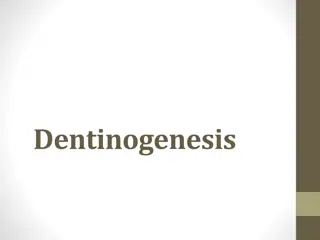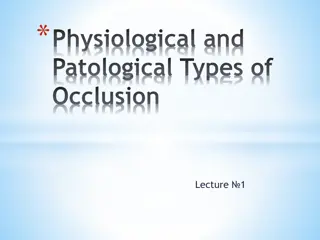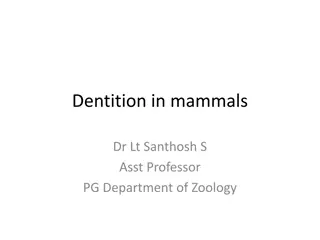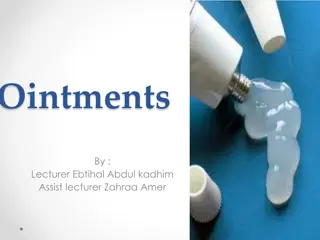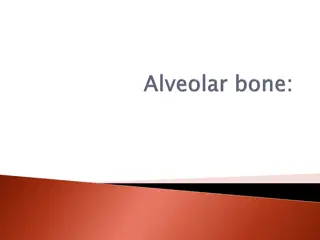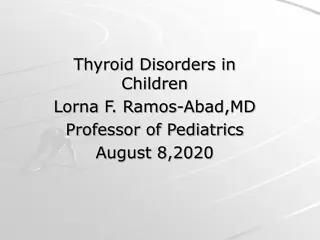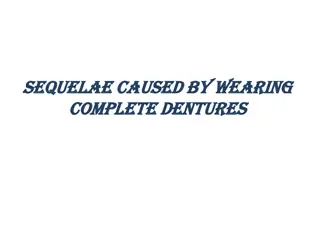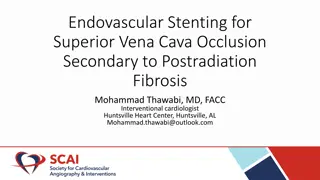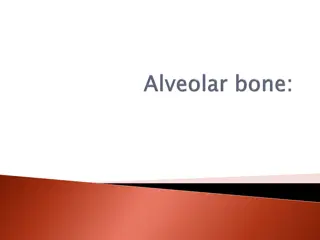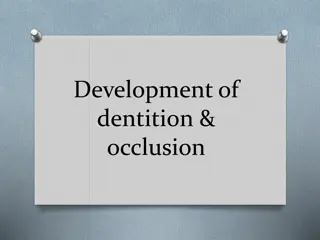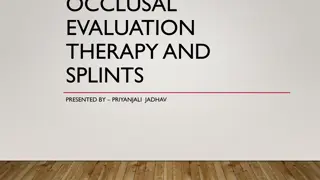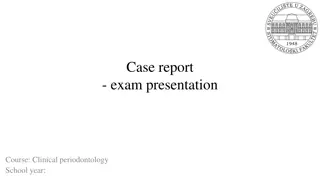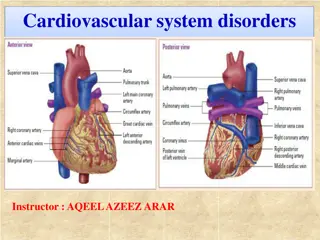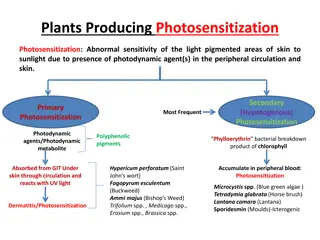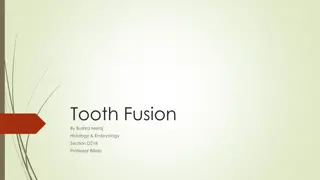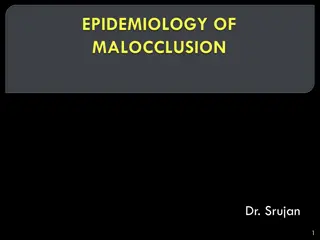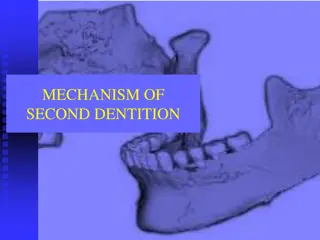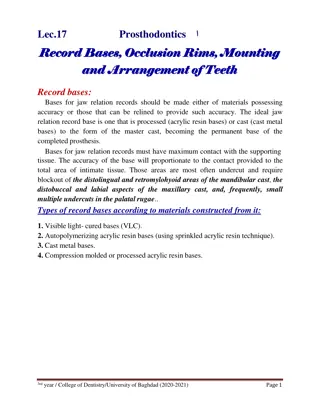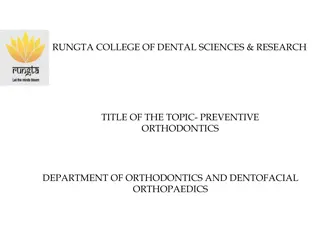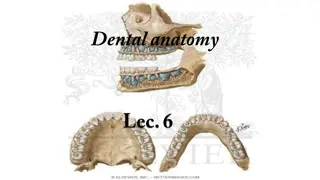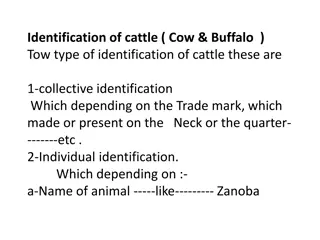Understanding the Development of Occlusion and Dentition
Exploring the stages of tooth development, eruption, theories, and keys to normal occlusion. Learn about primary and permanent dentition, dental formulae, dental lamina, odontogenic cells, and enamel organ formation in the process of tooth development.
Download Presentation

Please find below an Image/Link to download the presentation.
The content on the website is provided AS IS for your information and personal use only. It may not be sold, licensed, or shared on other websites without obtaining consent from the author. Download presentation by click this link. If you encounter any issues during the download, it is possible that the publisher has removed the file from their server.
E N D
Presentation Transcript
1 DEVELOPMENT OF OCCLUSION DEVELOPMENT OF OCCLUSION
2 Contents: 1. Introduction 2. Stages of Tooth Development 3. Eruption of Tooth 4. Theories of Eruption of Tooth 5. Development of Dentition 6. Stages of Development of Dentition 7. The Six Keys To Normal Occlusion 8. Conclusion 9. References
3 Introduction: The oral cavity contains a variety of soft and hard tissues. The soft tissues include the lining mucosa of the mouth and salivary gland. The hard tissues are the bones of the jaws and the tooth. The term dentition is used to describe the natural teeth in the jaw bones.
4 Humans have two sets of teeth in their lifetime. The first set of teeth to be seen in the mouth is the Primary or Deciduous dentition, which prenatally at about 14 weeks in utero and is completed postnatally at about 3 years of age and second set of teeth is Permanent or succedaneous dentition. begins to form
5 Formulae for Mammaliam Teeth: The dental formula for Primary/ deciduous dentition: I 2/2 C 1/1 M 2/2 =10 The dental formula for Permanent dentition: I 2/2 C1/1 P 2/2 M3/3 =16
6 Dental Lamina: Odontogenesis occurs in the 6th week of intrauterine life with the formation of primary epithelial band. At about 7th week primary epithelial band divides into lingual process called dental lamina and buccal process called vestibular lamina.
7 Odontogenic cells continue to proliferate forming ovoid swellings called enamel organs in the areas where teeth are going to form. All the deciduous teeth arise from this dental lamina, permanent successors arise from its lingual extension while permanent molars from its distal extension.
8 Enamel organ: The ectoderm in certain areas of dental lamina proliferates and forms knob like structures that grow into underlying mesenchyme. Each of these knobs represent a deciduous tooth and is called the enamel organ.
9 Stages Of Tooth Development: Tooth development is continuous process, the developmental history of tooth is divided into several morphologic stages. Stages are named after the shape of enamel organ ; 1. Bud stage 2. Cap stage 3. Bell stage 4. Advanced Bell stage
10 1. Bud Stage: In this stage there is formation of dental papilla and dental sac. Peripheral cells: Low columnar cells Central cells: Polygonal cells
11 2. Cap Stage: Stage is characterized by formation of enamel knot, enamel cord and enamel septa. Three layers are formed Outer enamel epithelium, Stellate reticulum, Inner enamel epithelium. Stellate reticulum acts as a shock absorber that protect the delicate enamel forming cells.
12 3. Bell Stage: In this stage, the crown shape is determined. Four layers are seen in this stage; Outer enamel epithelium, stellate reticulum, stratum intermedium, inner enamel epithelium. Stratum intermedium is rich in glycogen so helps in enamel formation. The junction of inner enamel epithelium and outer enamel epithelium is called cervical loop which marks the future CEJ.
14 4. Advanced Bell Stage: There is Commencement of mineralization and root formation. There is formation of future DEJ. Cervical portion of enamel organ gives rise to HERS, which molds the shape of roots and initiates radicular dentin formation. The differentiation of odontoblasts and the formation of dentin follow the lengthening of root sheath.
15 Inner enamel epithelium ameloblasts enamel Dental Papilla odontoblast dentin Outer enamel epithelium capillary network Dental sac periodontal ligament The junction between inner and outer enamel epithelium and odontoblast dentinoenamel junction.
16 An analysis of successive stages of growth of the tooth germ can also be organized and studied under the following headings: 1. Initiation 2. Proliferation 3. histodifferentiation 4. Morphodifferentiation 5. Apposition
17 1. Initiation: The initiation stage is first observed in six weeks old fetus. Recognized by the initial expansion of basal layer of oral cavity immediately above the basement membrane. Initiation of the entire deciduous dentition occurs during 2nd month in utero. Initiation of the entire permanent dentition starts from 5th month in utero. Initiation of the 1st permanent molar occurs at 4 months in utero. Initiation of the 2nd permanent molar at 1 year. Initiation of the 3rd permanent molar occurs at 4 to 5 year.
18 2. Proliferation: Further multiplication of the cells of the initiation stage and an expansion of the tooth bud which results in the formation of the tooth germ in the form of a cap. Any problem in the first two stages leads to Anodontia.
19 3. Histodifferentiation: This stage is marked by the histological difference in the appearance of the cells of the tooth germ as they begin to specialize. The tooth germ assumes the shape of bell in this stage. With the formation of dentin, the cells of the inner enamel epithelium differentiate into ameloblasts and enamel matrix is formed opposite the dentin.
20 4. Morphodifferentiation: It is the stage at which the cells find an arrangement that ultimately dictates the final size and shape of tooth. It coordinates with advanced bell stage. Problem in this stage leads to abnormalities in size and shape of teeth.
21 5. Apposition: It is the deposition of the matrix of the hard dental structure. It is the fulfillment of the plans outlined at the stages of histodifferentiation and morphodifferentiation. Characterized by the regular and rhythmic deposition of extracellular matrix, which is of itself incapable of further growth. This accounts for the layered appearance of enamel and dentin.
22 Nolla s Stages of Tooth Development
23 Eruption of Tooth: Eruption ( Latin word erumpere = to break out) Tooth eruption is complex series of events occurring in a continuous process to move the teeth in a three dimensional space. It is a developmental process and can be defined as, axial or occlusal movement of the tooth from its developmental position within the alveolar crypt in the jaw to its functional position in the occlusal plane within the oral cavity.
24 The entire process of tooth eruption may generally be described as follows: 1. Pre- eruptive tooth movement 2. Eruptive tooth movement 3. Post-eruptive tooth movement
25 1. Pre-eruptive tooth movement: Movements made by deciduous and permanent tooth germs within the tissues of the jaw before they begin to erupt. Tooth root begins its formation and begins to move toward the surface of the oral cavity from its bony vault. Two processes are necessary : 1)There must be resorption of bone and primary tooth roots overlying the crown of the erupting tooth. 2)The eruption mechanism itself then must move the tooth in the direction where the path has been cleared.
26 2. Eruptive Tooth Movement: Made by the tooth to move from its position within the bone of the jaw to its functional position in occlusion. This phase is divided into Intraosseous and Extraosseous components.
27 The term Prefunctional eruptive tooth movement is used to describe the movement of the tooth after its appearance in the oral cavity till it attains the functional position. It includes, the formation of the roots, the periodontal ligament, and dentogingival junction.
28 3. Post-Eruptive Tooth Movement: This occurs after the tooth has reached its functional position in occlusion. Post-eruptive tooth movements are: 1. Movements made to compensate for the continuous occlusal wear. 2. Movements made to compensate interproximal wear. 3. Movements to accommodate growing jaws. The movements compensating for occlusal and proximal wear continue throughout life and consist of axial and mesial migration, respectively.
29 When the tooth is in bony crypt, rate of eruption is about 1 per day. When the tooth comes out of the socket, eruption increases to 7.5 and after appearance in oral cavity, the eruption rate accelerates to 1mm per day. The final position of teeth in the oral cavity is determined by the pressure exerted by tongue, cheeks, lips and teeth which have come in contact.
30 Buccinator Mechanism: Starting with the decussating fibers of the orbicularis oris the buccinator runs laterally and posteriorly around the corner of mouth it inserts into the pterygomandibular raphe just behind the dentition. Here it mingles with fibers of superior constrictor which attaches to the pharyngeal tubercle of occipital bone.
31 Thus completely encircling the face. The teeth and the supporting structures are continuously under influence of contagious musculature buccinator and lips on other side.
32 Role of buccinator mechanism: The integrity of the dental arches and the relationship of the teeth to each other within each arch and with opposing members are result of morphogenetic factors as modified by stabilizing and active function forces of muscle on the tongue on one side and lips and cheek on other side. If cheek is destroyed the teeth begin to move outwards under the unopposed pressure from the tongue.
34 Post-emergent eruption consists of three stages: 1. Post-emergent spurt: This is the phase where there is rapid tooth movement after the tooth penetrates the gingiva till it reaches the occlusal level 2. Juvenile Occlusal Equilibrium: This is slow process, during which teeth erupt to compensate for the vertical growth of the mandibular ramus. 3. Adult Occlusal Equilibrium: Final phase of tooth eruption. Occurs after the pubertal growth spurt ends. -Tooth continuous to erupt when its antagonist is lost and also because of wear of the tooth structure.
35 Theories of Tooth Eruption: The mechanism that brings about tooth movement is still debatable and is likely to be a combination of number of factors. Four theories merit serious consideration: 1. Bone remodeling theory 2. Root formation theory 3. Vascular pressure theory 4. Periodontal ligament traction theory
36 1. Bone Remodeling Theory: This theory states selective bone formation and resorption which occurs, is the cause for tooth eruption. If the tooth germ is removed experimentally and dental follicle is left intact, an eruptive pathway forms in the overlying bone. If silicone replica is substituted for the tooth germ, it also erupts. If dental follicle is removed, no eruptive pathway forms. It is the follicle that provides the source for new bone-forming cells and for osteoclasts.
37 2. Root Formation Theory: Root formation would appear to be the most obvious cause of tooth eruption since it undoubtedly causes an overall increase in length of tooth along with the crown moving occlusally. Some experimental studies are strongly against such conclusion as rootless teeth have been found to erupt. This is most obvious in Dentin dysplasia type 1 and following irradiation.
38 The advocates of this theory postulated the existence of Cushion- hammock ligament, straddling the base of the socket from one bony wall to other like a sling. Its function was to provide fixed base to growing root. But this structure is actually a pulp-delineating membrane that runs across the apex of the tooth and has no bony insertion, so it can not act as a fixed base. For instance, some teeth move distance greater than the length of their roots, and eruptive tooth movement can occur even after completion of root formation.
39 3. Vascular Pressure Theory: It is known that the teeth move in their sockets in synchrony with the arterial pulse, so local volume changes can produce limited tooth movement. Spontaneous changes in blood pressure have been shown to influence eruptive behavior. Ground substance can swell from 30% to 50% by retaining additional water, so this also could create pressure.
40 But experimental surgical excision of the growing root and associated tissues which eliminates the periapical vasculature did not prevent or stop the eruption. This means that vascular pressure can play an important role by generating eruptive force but they are not absolutely necessary for tooth eruption.
41 4. Periodontal Ligament Traction Theory And The Role Of Dental Follicle : It states that the fibroblasts of the dental follicle by their contraction can generate a force, which can pull the teeth in occlusion. Fibroblasts have their processes attached to collagen fibers by a sticky protein called Fibronectin as the processes are in contact with each other it produces a summative force for eruption. Experiments in which roots have transected and metallic barrier was placed showed distal fragment of tooth erupted, this is because the attachment of dental follicle to the fragment.
42 The dental follicle plays important role in eruption. It produces factor for promoting osteoclastic bone resorption in the coronal part and by promoting bone formation in the apical part. Dental follicle cells secrete MCP-1 (monocyte chemotactic proteins-1), CSF- 1 (colony stimulating factor-1), which promotes osteoclast formation. According this theory, eruption could be brought about by combination of events involving a force initiated by the fibroblast.
43 Factors Affecting Eruption Of Teeth: The factors which affect tooth eruption can be grossly divided into two major categories: 1. Local factors 2. Systemic factors 1. Local Factors: Physical obstruction- Supernumerary teeth - Odontogenic and non-odontogenic tumours - Mucosal barrier -
44 Injuries to deciduous teeth: Premature loss of primary teeth - Dilacerations - Ankylosis - Delayed root resorption - Carious primary teeth Impacted Primary teeth Arch length deficiency Oral clefts
45 2. Systemic Factors: Nutrition Hormonal influences Cerebral Palsy HIV infection Anemia Low birth weight Long term chemotherapy Tobacco, smoking Genetic influence
46 Development of Occlusion: Occlusion usually means the contact relationship in function. Salzmann has defined occlusion as the changing inter- relationship of the opposing surfaces of the maxillary and mandibular teeth which occurs during movements of mandible and terminal full contact of maxillary and mandibular arches. It is sum total of many factors like genetic and environmental factors, muscular pressure, changes with development, maturity, ageing.
47 Periods of Dental Development: Stages of occlusion development are: 1. Predental stage or mouth of neonate (0-6 months) 2. Deciduous dentition (6months-6years) 3. Mixed dentition stage (6-12 years) -First transitional stage -Intertransitional stage -Second transitional stage 4. Permanent dentition
48 1. Mouth of Neonate/ Gum pads/ Pre-dentition stage(0-6 months) The alveolar arches at the time of birth are called Gum Pads. Basic form of arch is determined in the intrauterine life. Leighton has outlined various factors that determine size of gum pads as follows: - The state of maturity of infant at birth - The size at birth as expressed by birth weight - Size of developing primary teeth - Genetic factors
49 Maxillary shaped, develop in two parts, labiobuccal and lingual. arch is horse-shoe Labiobuccal portion divided into 10 segments by transverse groove corresponding to deciduous tooth sac.
50 Groove between canine and deciduous first molar is called Lateral sulcus. Labiobuccal and lingual portion is demarcated by Dental groove. Gingival groove demarcates the palate from gum pads.


